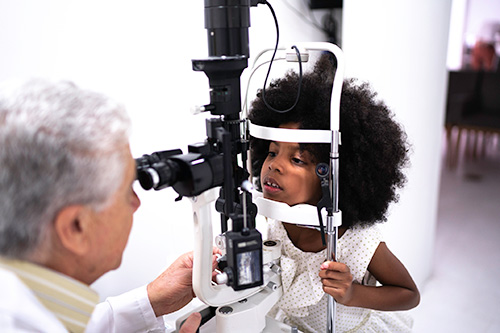Children and Contact Lenses

Children can safely and successfully wear contact lenses if they care for them properly. This often means having the support of a parent or other adult to help encourage healthy wear and care behaviors and reduce the risk of eye infections and other complications.
Children Can Successfully Wear Contact Lenses
Contact lenses can provide improved vision and other benefits for a wide spectrum of ages—including children 1-3. Children may experience benefits of contact lens wear beyond seeing better. Wearing contact lenses may improve children’s perceptions of their physical appearance compared with wearing glasses, and increase their confidence both in social interactions and in their ability to participate in athletic activities 2, 4, 5.
Contact Lenses are Not Risk-Free
Regardless of the wearer’s age, contact lenses are medical devices and are not risk-free 6. Contact lenses have been linked to serious eye infections and other types of complications. Contact lenses are a safe and effective form of vision correction for children, teenagers, and adults, as long as they are worn and cared for properly 2, 3, 7, 8.
Parents Play an Important Role
Children often depend on their parents or other adults for medical care. Parents play an active role in the day-to-day safety and health of their children, which includes vision and eye health—especially when it comes to the use of contact lenses. In addition to parental supervision, a child’s level of maturity, motivation to wear contact lenses, and personal hygiene are all things to consider. It is important for both parents and children to understand that they share in the responsibility to wear and care for contact lenses successfully.
Contact lenses are not the only option for vision correction, and parents who are considering contact lenses for their children should consult with an eye doctor to decide which option is most appropriate. All contact lens wearers should follow these healthy contact lens use tips.
- Lam DY, Kinoshita BT, Jansen ME, Mitchell GL, Chalmers RL, McMahon TT, Richdale K, Sorbara L, Wagner H. Contact lens assessment in youth: methods and baseline findings. Optom Vis Sci. 2011;88(6):708-15.
- Walline JJ, Jones LA, Sinnott L, Chitkara M, Coffey B, Jackson JM, Manny RE, Rah MJ, Prinstein MJ. Randomized trial of the effect of contact lens wear on self-perception in children. Optom Vis Sci. 2009;86(3):222-32.
- Walline JJ, Lorenz KO, Nichols JJ. Long-term contact lens wear of children and teens. Eye Contact Lens. 2013;39(4):283-9.
- Walline JJ, Gaume A, Jones LA, Rah MJ, Manny RE, Berntsen DA, Chitkara M, Kim A, Quinn N. Benefits of contact lens wear for children and teens. Eye Contact Lens. 2007;33(6 Pt 1):317-21.
- Rah MJ, Walline JJ, Jones-Jordan LA, Sinnott LT, Jackson JM, Manny RE, Coffey B, Lyons S, Group AS.Vision specific quality of life of pediatric contact lens wearers. Optom Vis Sci. 2010;87(8):560-6.
- Wang C, Hefflin B, Cope JU, Gross TP, Ritchie MB, Qi Y, Chu J. Emergency department visits for medical device-associated adverse events among children. 2010;126(2):247-59.
- Cho P, Cheung SW, Edwards M.The longitudinal orthokeratology research in children (LORIC) in Hong Kong: a pilot study on refractive changes and myopic control. Curr Eye Res. 2005;30(1):71-80.
- Jones-Jordan LA, Walline JJ, Mutti DO, Rah MJ, Nichols KK, Nichols JJ, Zadnik K. Gas permeable and soft contact lens wear in children. Optom Vis Sci. 2010;87(6):414-20.